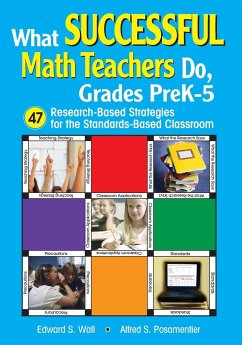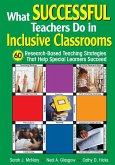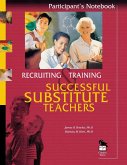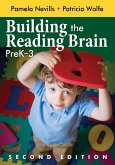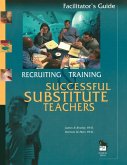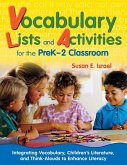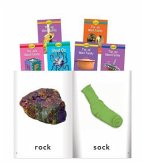Edward S. Wall, Alfred S. Posamentier
What Successful Math Teachers Do, Grades PreK-5
47 Research-Based Strategies for the Standards-Based Classroom
Edward S. Wall, Alfred S. Posamentier
What Successful Math Teachers Do, Grades PreK-5
47 Research-Based Strategies for the Standards-Based Classroom
- Broschiertes Buch
- Merkliste
- Auf die Merkliste
- Bewerten Bewerten
- Teilen
- Produkt teilen
- Produkterinnerung
- Produkterinnerung
The authors present dynamic learning activities with research-based strategies and sources for further reading to increase students' confidence in math while effectively addressing NCTM standards.
Andere Kunden interessierten sich auch für
![What Successful Teachers Do What Successful Teachers Do]() Neal A. GlasgowWhat Successful Teachers Do45,99 €
Neal A. GlasgowWhat Successful Teachers Do45,99 €![What Successful Teachers Do in Inclusive Classrooms What Successful Teachers Do in Inclusive Classrooms]() Sarah J. McnaryWhat Successful Teachers Do in Inclusive Classrooms34,99 €
Sarah J. McnaryWhat Successful Teachers Do in Inclusive Classrooms34,99 €![Recruiting and Training Successful Substitute Teachers Recruiting and Training Successful Substitute Teachers]() James B. RowleyRecruiting and Training Successful Substitute Teachers27,99 €
James B. RowleyRecruiting and Training Successful Substitute Teachers27,99 €![Building the Reading Brain, PreK-3 Building the Reading Brain, PreK-3]() Pamela NevillsBuilding the Reading Brain, PreK-341,99 €
Pamela NevillsBuilding the Reading Brain, PreK-341,99 €![Recruiting and Training Successful Substitute Teachers Recruiting and Training Successful Substitute Teachers]() James B RowleyRecruiting and Training Successful Substitute Teachers42,99 €
James B RowleyRecruiting and Training Successful Substitute Teachers42,99 €![Vocabulary Lists and Activities for the PreK-2 Classroom Vocabulary Lists and Activities for the PreK-2 Classroom]() Susan E. IsraelVocabulary Lists and Activities for the PreK-2 Classroom42,99 €
Susan E. IsraelVocabulary Lists and Activities for the PreK-2 Classroom42,99 €![Short O Word Families Set, Grades PreK-K Short O Word Families Set, Grades PreK-K]() Short O Word Families Set, Grades PreK-K22,99 €
Short O Word Families Set, Grades PreK-K22,99 €-
-
-
The authors present dynamic learning activities with research-based strategies and sources for further reading to increase students' confidence in math while effectively addressing NCTM standards.
Hinweis: Dieser Artikel kann nur an eine deutsche Lieferadresse ausgeliefert werden.
Hinweis: Dieser Artikel kann nur an eine deutsche Lieferadresse ausgeliefert werden.
Produktdetails
- Produktdetails
- Verlag: Corwin
- Seitenzahl: 168
- Erscheinungstermin: 14. September 2006
- Englisch
- Abmessung: 254mm x 178mm x 9mm
- Gewicht: 329g
- ISBN-13: 9781412915038
- ISBN-10: 1412915031
- Artikelnr.: 21390819
- Herstellerkennzeichnung
- Produktsicherheitsverantwortliche/r
- Europaallee 1
- 36244 Bad Hersfeld
- gpsr@libri.de
- Verlag: Corwin
- Seitenzahl: 168
- Erscheinungstermin: 14. September 2006
- Englisch
- Abmessung: 254mm x 178mm x 9mm
- Gewicht: 329g
- ISBN-13: 9781412915038
- ISBN-10: 1412915031
- Artikelnr.: 21390819
- Herstellerkennzeichnung
- Produktsicherheitsverantwortliche/r
- Europaallee 1
- 36244 Bad Hersfeld
- gpsr@libri.de
Edward S. Wall is assistant professor of elementary mathematics education at the City College of the City University of New York. In 1968 he received his MA in mathematics at the University of Maryland and, after a number of years working as an applied mathematician, received a Sloan Foundation Fellowship for the purposes of pursuing a PhD in mathematical biology at the University of Chicago. Along the way, he became intrigued by the very notion of teaching mathematics and, after several years, found himself deeply involved in full-time K-12 mathematics teaching. In 2003 he received a PhD in mathematics education at the University of Michigan and subsequently joined the faculty at City College. He still finds himself intrigued by the very notion of teaching mathematics and his research reflects that fascination.
Prologue Acknowledgments About the Authors 1. Numbers and Operations Grades PreK-2 1. Encourage young children
s exploration and understanding of relationships among numbers. 2. Encourage young children
s understanding of addition and subtraction and how they relate to each other. 3. Encourage young children
s fluent computation. Grades 3-5 4. Encourage an understanding of the structure of numbers and relationships among numbers. 5. Encourage an understanding of the meanings of multiplication and division and how they relate to each other. 6. Encourage students to compute fluently and make reasonable estimates. 2. Algebra Grades PreK-2 7. Encourage young children
s systematic sorting and classification as they work with a variety of patterns, geometric shapes, and data. 8. Encourage young children
s systematic exploration of the general principles and properties of operations such as addition and subtraction. Grades 3-5 9. Encourage the expression and generalization of mathematics relationships. 10. Encourage further understanding of multiplicative structures through application and analysis of the distributivity of multiplication over addition. 3. Geometry Grades PreK-2 11. Encourage young children
s exploration of characteristics and properties of two- and three-dimensional shapes. 12. Encourage young children
s application of similarity transformations to analyze geometric situations. 13. Encourage young children
s use of visualization and spatial reasoning in their exploration of geometric shapes. Grades 3-5 14. Encourage students
exploration and mathematical analysis of the properties of two-dimensional geometric shapes. 15. Encourage students
use of geometric transformations to analyze mathematical situations. 16. Encourage students
use of visualization, spatial reasoning, and geometric modeling to solve problems. 4. Measurement Grades PreK-2 17. Encourage young children
s exploration and understanding of measurement concepts and relationships. 18. Encourage young children to accurately apply appropriate tools and techniques to linear measurement. Grades 3-5 19. Encourage students
exploration and understanding of measurement concepts and relationships. 20. Encourage students
appropriate application of conventional measuring tools in varied situations. 5. Data Analysis and Probability Grades PreK-2 21. Encourage young children
s collection, display, and organization of objects and data. 22. Encourage the idea in young children that data, graphs, and charts give information. 23. Encourage young children
s informal explorations of probability. Grades 3-5 24. Encourage students to explore questions they find personally relevant and that can be addressed by data collection and analysis. 25. Encourage students to become more precise in their mathematical descriptions of data. 26. Encourage students to explore and evaluate issues of representativeness and inference. 27. Encourage students
exploration and quantification of simple probabilistic events. 6. Problem Solving Grades PreK-2 28. Encourage young children to ask mathematical questions and to identify essential mathematical information. 29. Assess young children
s abilities to solve problems through examination of student work and conversations. Grades 3-5 30. Encourage students
development and application of problem-solving strategies. 31. Select rich, appropriate, and challenging problems and orchestrate their use. 7. Reasoning and Proof Grades PreK-2 32. Encourage young children to explain their thinking by stating their reasons. 33. Ask questions that encourage young children to make conjectures and to justify their thinking. Grades 3-5 34. Encourage children to reason about the relationships that apply to the numbers, operations, or shapes that they are studying. 35. Focus on general mathematical structures and relationships. 8. Communication Grades PreK-2 36. Encourage young children
s verbal and written communication of mathematics concepts and ideas. 37. Expect young children to explain their thinking and give them opportunities to talk with and listen to their peers. Grades 3-5 38. Encourage students to share their thinking, to ask questions, and to justify their ideas. 39. Provide models for student dialogue about mathematics. 9. Connections Grades PreK-2 40. Encourage young children to make connections among mathematical ideas, vocabulary, and representations. 41. Make links between routine school activities and mathematics. Grades 3-5 42. Encourage students to see that mathematics is a web of closely connected ideas. 43. Select tasks that help students explore and develop increasingly sophisticated mathematical ideas. 10. Representation Grades PreK-2 44. Encourage young children to represent their mathematical ideas and procedures in varied ways. 45. Create a learning environment that supports and encourages children
s use of multiple representations. Grades 3-5 46. Encourage students to use representations to support, clarify, and extend their mathematical ideas. 47. Choose tasks that embody rich and varied representational structures. Epilogue Index
s exploration and understanding of relationships among numbers. 2. Encourage young children
s understanding of addition and subtraction and how they relate to each other. 3. Encourage young children
s fluent computation. Grades 3-5 4. Encourage an understanding of the structure of numbers and relationships among numbers. 5. Encourage an understanding of the meanings of multiplication and division and how they relate to each other. 6. Encourage students to compute fluently and make reasonable estimates. 2. Algebra Grades PreK-2 7. Encourage young children
s systematic sorting and classification as they work with a variety of patterns, geometric shapes, and data. 8. Encourage young children
s systematic exploration of the general principles and properties of operations such as addition and subtraction. Grades 3-5 9. Encourage the expression and generalization of mathematics relationships. 10. Encourage further understanding of multiplicative structures through application and analysis of the distributivity of multiplication over addition. 3. Geometry Grades PreK-2 11. Encourage young children
s exploration of characteristics and properties of two- and three-dimensional shapes. 12. Encourage young children
s application of similarity transformations to analyze geometric situations. 13. Encourage young children
s use of visualization and spatial reasoning in their exploration of geometric shapes. Grades 3-5 14. Encourage students
exploration and mathematical analysis of the properties of two-dimensional geometric shapes. 15. Encourage students
use of geometric transformations to analyze mathematical situations. 16. Encourage students
use of visualization, spatial reasoning, and geometric modeling to solve problems. 4. Measurement Grades PreK-2 17. Encourage young children
s exploration and understanding of measurement concepts and relationships. 18. Encourage young children to accurately apply appropriate tools and techniques to linear measurement. Grades 3-5 19. Encourage students
exploration and understanding of measurement concepts and relationships. 20. Encourage students
appropriate application of conventional measuring tools in varied situations. 5. Data Analysis and Probability Grades PreK-2 21. Encourage young children
s collection, display, and organization of objects and data. 22. Encourage the idea in young children that data, graphs, and charts give information. 23. Encourage young children
s informal explorations of probability. Grades 3-5 24. Encourage students to explore questions they find personally relevant and that can be addressed by data collection and analysis. 25. Encourage students to become more precise in their mathematical descriptions of data. 26. Encourage students to explore and evaluate issues of representativeness and inference. 27. Encourage students
exploration and quantification of simple probabilistic events. 6. Problem Solving Grades PreK-2 28. Encourage young children to ask mathematical questions and to identify essential mathematical information. 29. Assess young children
s abilities to solve problems through examination of student work and conversations. Grades 3-5 30. Encourage students
development and application of problem-solving strategies. 31. Select rich, appropriate, and challenging problems and orchestrate their use. 7. Reasoning and Proof Grades PreK-2 32. Encourage young children to explain their thinking by stating their reasons. 33. Ask questions that encourage young children to make conjectures and to justify their thinking. Grades 3-5 34. Encourage children to reason about the relationships that apply to the numbers, operations, or shapes that they are studying. 35. Focus on general mathematical structures and relationships. 8. Communication Grades PreK-2 36. Encourage young children
s verbal and written communication of mathematics concepts and ideas. 37. Expect young children to explain their thinking and give them opportunities to talk with and listen to their peers. Grades 3-5 38. Encourage students to share their thinking, to ask questions, and to justify their ideas. 39. Provide models for student dialogue about mathematics. 9. Connections Grades PreK-2 40. Encourage young children to make connections among mathematical ideas, vocabulary, and representations. 41. Make links between routine school activities and mathematics. Grades 3-5 42. Encourage students to see that mathematics is a web of closely connected ideas. 43. Select tasks that help students explore and develop increasingly sophisticated mathematical ideas. 10. Representation Grades PreK-2 44. Encourage young children to represent their mathematical ideas and procedures in varied ways. 45. Create a learning environment that supports and encourages children
s use of multiple representations. Grades 3-5 46. Encourage students to use representations to support, clarify, and extend their mathematical ideas. 47. Choose tasks that embody rich and varied representational structures. Epilogue Index
Prologue Acknowledgments About the Authors 1. Numbers and Operations Grades PreK-2 1. Encourage young children
s exploration and understanding of relationships among numbers. 2. Encourage young children
s understanding of addition and subtraction and how they relate to each other. 3. Encourage young children
s fluent computation. Grades 3-5 4. Encourage an understanding of the structure of numbers and relationships among numbers. 5. Encourage an understanding of the meanings of multiplication and division and how they relate to each other. 6. Encourage students to compute fluently and make reasonable estimates. 2. Algebra Grades PreK-2 7. Encourage young children
s systematic sorting and classification as they work with a variety of patterns, geometric shapes, and data. 8. Encourage young children
s systematic exploration of the general principles and properties of operations such as addition and subtraction. Grades 3-5 9. Encourage the expression and generalization of mathematics relationships. 10. Encourage further understanding of multiplicative structures through application and analysis of the distributivity of multiplication over addition. 3. Geometry Grades PreK-2 11. Encourage young children
s exploration of characteristics and properties of two- and three-dimensional shapes. 12. Encourage young children
s application of similarity transformations to analyze geometric situations. 13. Encourage young children
s use of visualization and spatial reasoning in their exploration of geometric shapes. Grades 3-5 14. Encourage students
exploration and mathematical analysis of the properties of two-dimensional geometric shapes. 15. Encourage students
use of geometric transformations to analyze mathematical situations. 16. Encourage students
use of visualization, spatial reasoning, and geometric modeling to solve problems. 4. Measurement Grades PreK-2 17. Encourage young children
s exploration and understanding of measurement concepts and relationships. 18. Encourage young children to accurately apply appropriate tools and techniques to linear measurement. Grades 3-5 19. Encourage students
exploration and understanding of measurement concepts and relationships. 20. Encourage students
appropriate application of conventional measuring tools in varied situations. 5. Data Analysis and Probability Grades PreK-2 21. Encourage young children
s collection, display, and organization of objects and data. 22. Encourage the idea in young children that data, graphs, and charts give information. 23. Encourage young children
s informal explorations of probability. Grades 3-5 24. Encourage students to explore questions they find personally relevant and that can be addressed by data collection and analysis. 25. Encourage students to become more precise in their mathematical descriptions of data. 26. Encourage students to explore and evaluate issues of representativeness and inference. 27. Encourage students
exploration and quantification of simple probabilistic events. 6. Problem Solving Grades PreK-2 28. Encourage young children to ask mathematical questions and to identify essential mathematical information. 29. Assess young children
s abilities to solve problems through examination of student work and conversations. Grades 3-5 30. Encourage students
development and application of problem-solving strategies. 31. Select rich, appropriate, and challenging problems and orchestrate their use. 7. Reasoning and Proof Grades PreK-2 32. Encourage young children to explain their thinking by stating their reasons. 33. Ask questions that encourage young children to make conjectures and to justify their thinking. Grades 3-5 34. Encourage children to reason about the relationships that apply to the numbers, operations, or shapes that they are studying. 35. Focus on general mathematical structures and relationships. 8. Communication Grades PreK-2 36. Encourage young children
s verbal and written communication of mathematics concepts and ideas. 37. Expect young children to explain their thinking and give them opportunities to talk with and listen to their peers. Grades 3-5 38. Encourage students to share their thinking, to ask questions, and to justify their ideas. 39. Provide models for student dialogue about mathematics. 9. Connections Grades PreK-2 40. Encourage young children to make connections among mathematical ideas, vocabulary, and representations. 41. Make links between routine school activities and mathematics. Grades 3-5 42. Encourage students to see that mathematics is a web of closely connected ideas. 43. Select tasks that help students explore and develop increasingly sophisticated mathematical ideas. 10. Representation Grades PreK-2 44. Encourage young children to represent their mathematical ideas and procedures in varied ways. 45. Create a learning environment that supports and encourages children
s use of multiple representations. Grades 3-5 46. Encourage students to use representations to support, clarify, and extend their mathematical ideas. 47. Choose tasks that embody rich and varied representational structures. Epilogue Index
s exploration and understanding of relationships among numbers. 2. Encourage young children
s understanding of addition and subtraction and how they relate to each other. 3. Encourage young children
s fluent computation. Grades 3-5 4. Encourage an understanding of the structure of numbers and relationships among numbers. 5. Encourage an understanding of the meanings of multiplication and division and how they relate to each other. 6. Encourage students to compute fluently and make reasonable estimates. 2. Algebra Grades PreK-2 7. Encourage young children
s systematic sorting and classification as they work with a variety of patterns, geometric shapes, and data. 8. Encourage young children
s systematic exploration of the general principles and properties of operations such as addition and subtraction. Grades 3-5 9. Encourage the expression and generalization of mathematics relationships. 10. Encourage further understanding of multiplicative structures through application and analysis of the distributivity of multiplication over addition. 3. Geometry Grades PreK-2 11. Encourage young children
s exploration of characteristics and properties of two- and three-dimensional shapes. 12. Encourage young children
s application of similarity transformations to analyze geometric situations. 13. Encourage young children
s use of visualization and spatial reasoning in their exploration of geometric shapes. Grades 3-5 14. Encourage students
exploration and mathematical analysis of the properties of two-dimensional geometric shapes. 15. Encourage students
use of geometric transformations to analyze mathematical situations. 16. Encourage students
use of visualization, spatial reasoning, and geometric modeling to solve problems. 4. Measurement Grades PreK-2 17. Encourage young children
s exploration and understanding of measurement concepts and relationships. 18. Encourage young children to accurately apply appropriate tools and techniques to linear measurement. Grades 3-5 19. Encourage students
exploration and understanding of measurement concepts and relationships. 20. Encourage students
appropriate application of conventional measuring tools in varied situations. 5. Data Analysis and Probability Grades PreK-2 21. Encourage young children
s collection, display, and organization of objects and data. 22. Encourage the idea in young children that data, graphs, and charts give information. 23. Encourage young children
s informal explorations of probability. Grades 3-5 24. Encourage students to explore questions they find personally relevant and that can be addressed by data collection and analysis. 25. Encourage students to become more precise in their mathematical descriptions of data. 26. Encourage students to explore and evaluate issues of representativeness and inference. 27. Encourage students
exploration and quantification of simple probabilistic events. 6. Problem Solving Grades PreK-2 28. Encourage young children to ask mathematical questions and to identify essential mathematical information. 29. Assess young children
s abilities to solve problems through examination of student work and conversations. Grades 3-5 30. Encourage students
development and application of problem-solving strategies. 31. Select rich, appropriate, and challenging problems and orchestrate their use. 7. Reasoning and Proof Grades PreK-2 32. Encourage young children to explain their thinking by stating their reasons. 33. Ask questions that encourage young children to make conjectures and to justify their thinking. Grades 3-5 34. Encourage children to reason about the relationships that apply to the numbers, operations, or shapes that they are studying. 35. Focus on general mathematical structures and relationships. 8. Communication Grades PreK-2 36. Encourage young children
s verbal and written communication of mathematics concepts and ideas. 37. Expect young children to explain their thinking and give them opportunities to talk with and listen to their peers. Grades 3-5 38. Encourage students to share their thinking, to ask questions, and to justify their ideas. 39. Provide models for student dialogue about mathematics. 9. Connections Grades PreK-2 40. Encourage young children to make connections among mathematical ideas, vocabulary, and representations. 41. Make links between routine school activities and mathematics. Grades 3-5 42. Encourage students to see that mathematics is a web of closely connected ideas. 43. Select tasks that help students explore and develop increasingly sophisticated mathematical ideas. 10. Representation Grades PreK-2 44. Encourage young children to represent their mathematical ideas and procedures in varied ways. 45. Create a learning environment that supports and encourages children
s use of multiple representations. Grades 3-5 46. Encourage students to use representations to support, clarify, and extend their mathematical ideas. 47. Choose tasks that embody rich and varied representational structures. Epilogue Index

